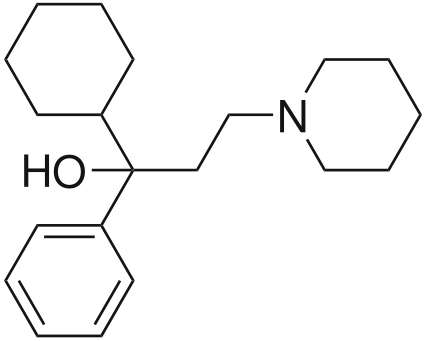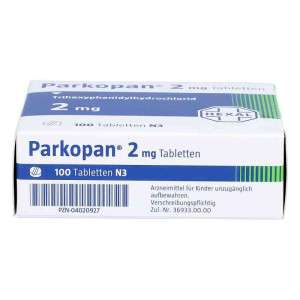
Parkopan (trihexyphenidyl)
Parkopan (cyclodol, trihexyphenidyl, parkinsan, romparkin, parkopan, anti-spas, antitrem, aparkan, artane, benzhexol hydrochloride, pacitane, parkan, parkinsan, peragit, romparkin, trihetphenidili hydrochloridum, trihexyphenidyl hydrochloride, triphenidyl). The international name is trihexyphenidyl.
White fine crystalline powder. Slightly soluble in water, slowly soluble in alcohol. The active substance is trihexyphenidyl hydrochloride. Tablets 0.002 and 0.005 g.
At a high dosage, the drug causes euphoria and hallucinations. In the USSR, with its strict policy against drug addiction, Parkopan was very popular in the absence of other drugs. It began to be used for narcotic purposes in the USSR in the late 50s – early 60s and became the Soviet analogue of the RSR in terms of prevalence.

Parkopan The fashion for Parkopan (Cyclodol) came from psychiatric hospitals. In the medical practice of those years, aminazine appeared, which revolutionized previously existing approaches to mental illness. The drug has become incredibly widespread – it was received by almost all patients suffering from schizophrenic psychosis. But it also had side effects. In particular, the neuroleptic caused movement coordination disorders – the so-called neuroleptic or extrapyramidal syndrome. Therefore, Parkopan was prescribed to almost all patients to prevent complications simultaneously with aminazine. Patients quickly found out that the slightest overdose of Parkopan causes an intoxicating effect, and an even greater increase in the dose (with the cancellation of aminazine) leads to hallucinations.
Indications.
Parkinson’s syndrome (monotherapy, combination therapy with levodopa).
Dosage regimen.
The dose of the drug should be set individually, starting with the lowest and increasing it to the most effective. For adults, the initial dose is 1 mg of trihexyphenidyl hydrochloride per day. The dose can be increased by 1 mg every day. The maintenance dose is 6-16 mg / day, divided into 3-4 doses, the maximum daily dose is 16 mg. The maintenance dose depends on the individual reaction of the patient to taking the drug. Avoid rapid changes in dosage, abrupt interruption or discontinuation of therapy.
By its mechanism of action, Parkopan is an antagonist of M-cholinergic receptors of central and peripheral action. The central action prevails over the peripheral one and helps to reduce the severity or eliminate motor disorders caused by extrapyramidal disorders.
Parkopan (Cyclodol) helps to reduce tremor of the limbs at rest; to a lesser extent it affects rigidity and bradykinesia. Due to the cholinolytic effect of the drug, salivation decreases, to a lesser extent – sweating and greasiness of the skin. This drug also has an antispasmodic effect, which is due to anticholinergic activity and direct myotropic effect. Parkopan, both as monotherapy and as part of combination therapy, is indicated for Parkinson’s disease and secondary Parkinsonism syndrome. The drug is also used for extrapyramidal symptoms that develop as a result of taking neuroleptics, as well as for other extrapyramidal motor disorders (generalized and segmental dystonia). Parkopan in some cases reduces tone and improves motor function in pyramidal paresis.
The drug is contraindicated in glaucoma (especially with angle closure), benign prostatic hyperplasia with the presence of residual urine, atrial fibrillation, acute urinary retention, acute delirium, mania and some other conditions.
Parkopan (Cyclodol) is taken immediately in a large dose and is often washed down not with water, but with beer or wine. When combined with alcohol, delirium lasts longer and proceeds more intensively. Drinking alcohol with large (hallucinogenic) doses of Parkopan is extremely dangerous, since a complete loss of self-control is possible.
Rapid withdrawal from Parkopan intoxication is carried out by injections of aminazine (50-100 mg intramuscularly) or sibazone (relanium, seduxen) also intramuscularly – 24 ml of 0.5% solution (10-20 mg). After the injection, a long sleep soon follows. Upon awakening, only asthenia remains.
Parkopan “holinolytic” – blocks synapses in which acetylcholine is the mediator. Like atropine, only “central”, acts mainly on the brain. It has a strong central n-cholinolytic effect, as well as peripheral m-cholinolytic effect. A more powerful analogue is the military taran.
Caution should be observed with hypertension, severe atherosclerosis, heart, liver and kidney diseases.
Pharmacological action of Parkopan (Cyclodol).
Antiparkinsonian remedy. It has a central and peripheral cholinolytic effect.
There are 4 stages of intoxication: euphoria, narrowing of consciousness, hallucinatory phase and exit.
The first phase. It is associated with a rise in mood, or euphoria – a dosage of 3 mg (without alcohol). Develops 20-30 minutes after taking the pills. There is a feeling of warmth, primarily in the hands and feet. Well-being is pleasant, there is lightness in the body. Everyday troubles fade into the background. The consumer becomes talkative; movements, initially smooth, noticeably accelerate. Intoxication can take place even unnoticed by others. This state lasts for about twenty minutes and is replaced by the second phase.
The second phase. After 40-45 minutes, the effect is already different – euphoria is absent or is replaced by dysphoria, there is inhibition in movements, a desire to lie down, dizziness and a peculiar feeling of weightlessness. A person can be thrown “into the heat, then into the cold.” Different consumers perceive sensations differently: both as pleasant and as intimidating. In any case, in this state, a person is unable to articulate thoughts clearly. It is characteristic that, unlike some other hallucinogens, the picture of intoxication with Parkopan is well remembered. Vegetative disorders are reduced to accommodation paralysis (vision deteriorates, it is impossible to read the fine print). Due to the cholinolytic effect of Parkopan, salivation decreases (it is difficult to eat anything), sweating and greasiness of the skin to a lesser extent. Pupils dilate, facial hyperemia, intentional tremor, moderate tachycardia are often noted. The second phase lasts about half an hour, depending on the dose of Parkopan.
The third phase is the period of hallucinations, but this phase may not develop. It all depends on the dose of the drug and individual tolerance. The consumer ceases to orient himself in time and space. Images of people or animals appear. The semantic content of hallucinations (as well as the affective background on which they occur) depends on the situation preceding intoxication and the emotional reaction to this situation. If the Parkopan was adopted in the company of friends, during fun and carefree chatter, then the visions represent rainbow pictures, funny incidents, entertaining scenes. If the intoxication was preceded by clashes, fights, quarrels, fears of being beaten or other frightening events, then fear prevails in the delirium picture, bandits, pursuers, scenes of attacks are seen. But in all cases, hallucinations are distinguished by kaleidoscopic, rapid change of various episodes and pictures. However, the same scenes can be repeated several times.
Often there is a kind of “disappearing cigarette symptom”, characteristic of psychoses caused by cholinolytic drugs. When a person has a feeling that a cigarette is clamped between his fingers. As soon as he tries to bring it to his mouth and the hand is in sight, the cigarette “disappears”. The man looks at his hand with bewilderment. Thinking that he dropped the cigarette, he starts looking for it on the floor, examines his clothes.
At very high doses, imaginary interlocutors may occur. During the action, memory lapses occur, up to the inability to recall what has just been said. Hallucinations can last up to 40 hours. The action of Parkopan is often interrupted by light intervals – they last from a few minutes to half an hour. During these periods, hallucinations stop (or become less intense), consciousness clears up.
The fourth phase. Instead of lightness, the body is filled with heaviness, fatigue is piled up to a feeling of complete exhaustion. I really want to sleep, but it’s impossible to fall asleep. After about 8-12 hours, the condition gradually normalizes.
Former hallucinatory experiences are well remembered, they can be shared with others, subjected to critical processing. Delusional ideas based on former hallucinations do not develop. But in the case when an overdose occurs and a person loses control over himself, the period of action is not remembered (by analogy with alcohol intoxication).
Side effect.
Dry mucous membranes, redness of the skin, dizziness, nausea, vomiting, tachycardia, a feeling of compression in the head, fatigue, lethargy of muscles, decreased activity of sweat glands, constipation, violation of accommodation, provocation of glaucoma, violation of urination, especially with prostate adenoma, psychosis, allergic reactions.
Contraindications.
Mechanical stenosis of the gastrointestinal tract, megacolon, prostate adenoma with the presence of residual urine, early pregnancy, tachycardia, tachyarrhythmia, acute pulmonary edema. Caution – with glaucoma, psychosis, fresh myocardial infarction.
Under the influence of the drug, drug dependence may develop. During treatment, it is not recommended to engage in activities that require increased attention.
After six months of use, the work of the brain is disrupted. A person is not able to remember even a phone number. The ability to think logically is falling. Deep organic dementia (dementia) begins to develop.
When taking excessively large doses of cyclodol, the effect can go into sopor and coma.
Hallucinogenic effect:
With an overdose, parkopan (cyclodol), like some other strong central cholinolytics, causes a kind of “cholinolytic intoxication”, which is accompanied by euphoria (may later be replaced by dysphoria), therefore addiction is possible; impaired coordination of movements (ataxia), paresis of eye accommodation.
With an even more severe overdose, cyclodol can cause hallucinations and delirium, memory impairment and orientation in time and space – the so-called “cholinolytic delirium”. Life-threatening seizures, cardiac arrhythmias are possible. Fatal outcomes are also possible as a result of psychosis itself (for example, a patient can step through a window instead of a door).
Cyclodolic delirium is stopped by the introduction of neuroleptics (aminazine) or tranquilizers (sibazone).
